A carne adovada comparison post is a very bad idea because:
1. I don’t love cooking with meat, with the constant hand-washing and being careful not to contaminate cooked meat tools with raw meat tools.
2. My limited counter space makes working with large roasts difficult.
3. The oven was on for four hours – in July.
4. One of the recipes includes the warning “Don’t breathe the fumes!”
5. Another warning, this time from my sister: “My coworker said to be careful because red chile can give some people the runs if they aren’t used to eating it.”
6. Carne adovada is red. Deep, dark red, and yes, of course it stains.
7. Who, outside of New Mexico, has even heard of carne adovada?
Oh, and then, the outcome?
8. Dave thought all three recipes tasted the same anyway.
Carne adovada is pork marinated in red chile sauce, then slow roasted. It isn’t something that I’ve eaten a lot of; my dad made it once when I was young and it was crazy ridiculously painfully spicy, and I’ve pretty much been scared of it since. Of course now I realize that the level of spiciness will vary with the heat of the chiles.
Unable, as usual, to decide on a recipe, I decided to compare a few. The meat in all recipes is marinated and cooked using the same method and cooking time; the difference is in the red chile sauce. At its most simple, the red chiles are soaked in hot water to rehydrate them, then blended with onions, garlic, and salt. Jen’s method is only slightly more complicated, with the added step of toasting the dried chiles before soaking them.
Kate’s recipe is a little more complicated – and uses far, far more red chiles. It’s similar but significantly more fussy, with a soak followed by a simmer instead of just a soak, and then the blended ingredients need to be pushed through a sieve, a step I find tedious in most recipes that call for it.
I let the meat marinate for about 24 hours, but if you can swing longer, up to 2 full days, I really think that’s the way to go. The more red chile flavor, the better.
After finding enough properly-sized baking pans, jigsawing the pans into the oven, roasting the meat for hours, letting it cool slightly, and shredding all three pans of meat while trying to keep straight which was which so I could identify the photos, Dave and I decided that they were very, very similar.
Dave would say identical. I would say that they’re oh-so-slightly different, but equally good. Kate’s recipe, which used so much more chiles, was spiciest. The recipe that did not require toasting the chiles tasted lighter and fresher, while the recipe with toasted chiles had a deeper flavor.
My favorite was probably the simplest recipe; I liked that fresh flavor. Plus, if they all taste essentially the same, I might as well make the easiest, right? I guess a comparison was necessary, just so I know that, in this case, simple works just fine.
Update: I thought I should add that neither of us had any, ah, digestive issues after eating the red chile, despite the concerns of my sister and her coworker.
One year ago: Baked Eggs with Spinach and Mushrooms
Serving suggestions: Burritos, stuffed sopaipillas (shown in the top photo), quesadillas, tacos, breakfast burritos. You can also add potatoes to the mixture before cooking, and then serve the potatoes and meat as a main dish with beans and rice as sides.
Printer Friendly Recipe
Carne Adovada (adapted from Simply Simpatico, by the Junior League of Albuquerque)
16-18 dried red chile pods
hot water
3 cloves garlic
2 teaspoons salt
1 tablespoon dried oregano
4 pounds pork shoulder, trimmed of thick layer of fat and sliced ½-inch thick
1. Remove stems and seeds from the chile pods. Place the pods in a large bowl or pot and pour in enough hot water to cover them. Soak for 1 hour. Strain, reserving the soaking liquid.
2. Place the chiles, garlic, and salt in a blender and add enough soaking liquid to just cover. Making sure there’s about two inches of headspace, blend until the skins disappear and the mixture is smooth, 2-3 minutes. Pour the sauce over meat, cover tightly, and marinate in the refrigerator for 24-28 hours.
3. Adjust a rack to the middle position and heat the oven to 350ºF. Place the meat and chile sauce marinade in a baking pan and cover tightly with foil. Bake the carne adovada until the meat is falling apart tender, about 4 hours. (You can also cook the carne adovada in a crockpot on low heat for 7-9 hours.) When the meat is done, shred it or cut it into 1-inch pieces. Serve.
Printer Friendly Recipe
Carne Adovado (adapted from Jen at Use Real Butter, who adapted it from Sante Fe Recipe)
16 dried red chile pods
1 tablespoon salt
4 cloves garlic
2 teaspoons oregano
5 pounds pork shoulder, trimmed of thick layer of fat and sliced ½-inch thick
1. Adjust an oven rack to the middle position and heat the oven to 325ºF. Remove the stems from the chile pods; place the pods in a pan and bake for 5-10 minutes, stirring occasionally, until the chiles are lightly roasted. Leave the oven door open, and don’t breathe the fumes! Shake the seeds out of the pods and discard them.
2. Place the chiles in a medium bowl and cover them with boiling water. Let them sit for 30 minutes. Drain the water, reserving about 2 cups. Place the chiles in a food processor or blender; add the salt, garlic, and oregano. Cover the mixture with the reserved chile water, and blend or process for 2 minutes or until the skins disappear.
3. Pour the sauce over meat, cover tightly, and marinate in the refrigerator for 24-28 hours.
4. Adjust a rack to the middle position and heat the oven to 350ºF. Place the meat and chile sauce marinade in a baking pan and cover tightly with foil. Bake the carne adovada until the meat is falling apart tender, about 4 hours. (You can also cook the carne adovada in a crockpot on low heat for 7-9 hours.) When the meat is done, shred it or cut it into 1-inch pieces. Serve.
Printer Friendly Recipe
Carne Adovada (adapted from Kate in the Kitchen , who adapted it from Sante Fe Hot and Spicy Recipes)
12 ounces dried red chile peppers
1 large onion, chopped
8 cloves fresh garlic, smashed with skins removed
2 teaspoons dried oregano
2 teaspoons ground cumin
2 teaspoon kosher salt
3-4 pounds pork shoulder, trimmed of thick layer of fat and sliced ½-inch thick
4 teaspoons red pepper flakes
2 sticks cinnamon
1. De-stem and de-seed chile peppers; place in a large stock pot and cover with hot water. Soak for 30 minutes. Add the remaining ingredients to the pot; bring to a boil. Reduce the heat to low and simmer for 30 minutes.
2. Strain, reserving liquid. Allow to cool slightly, then process solids in batches in a food processor using reserve liquid for proper consistency. Strain through a wire sieve, pressing on the solids to extract the liquids.
3. Pour the sauce over meat, add the cinnamon and red pepper flakes, cover tightly, and marinate in the refrigerator for 24-28 hours.
4. Adjust a rack to the middle position and heat the oven to 350ºF. Remove the cinnamon stick. Place the meat and chile sauce marinade in a baking pan and cover tightly with foil. Bake the carne adovada until the meat is falling apart tender, about 4 hours. (You can also cook the carne adovada in a crockpot on low heat for 7-9 hours.) When the meat is done, shred it or cut it into 1-inch pieces. Serve.
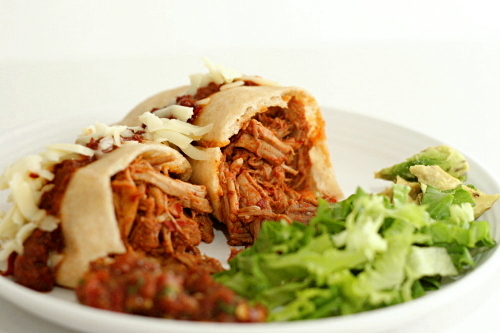
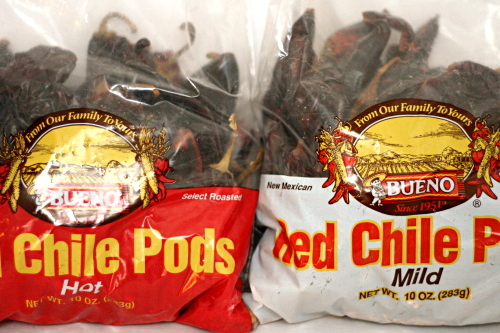
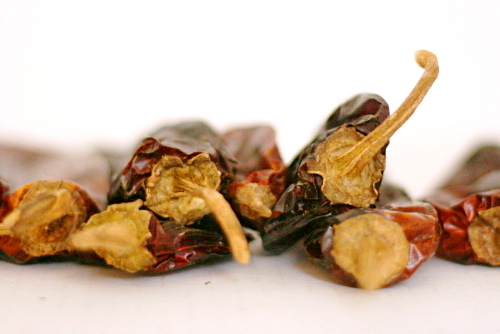


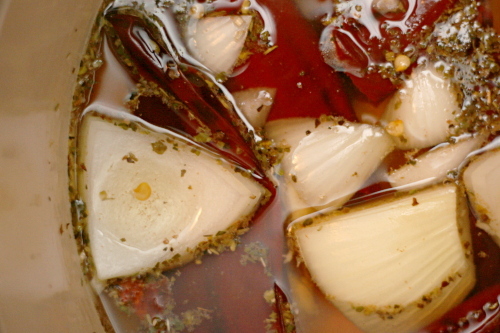


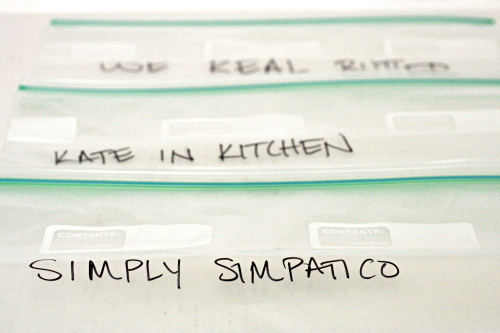
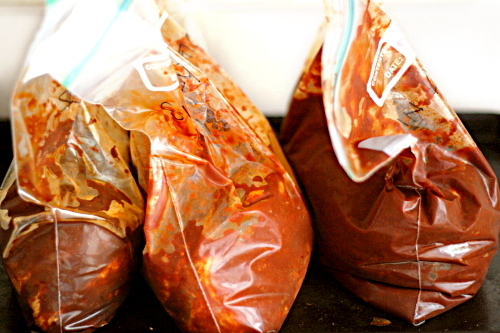


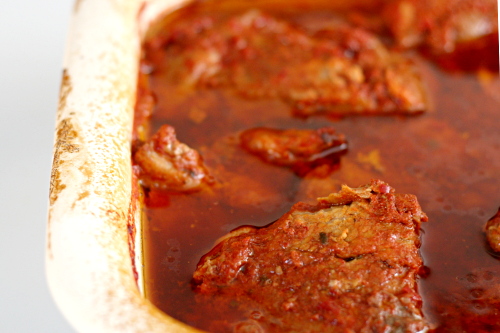
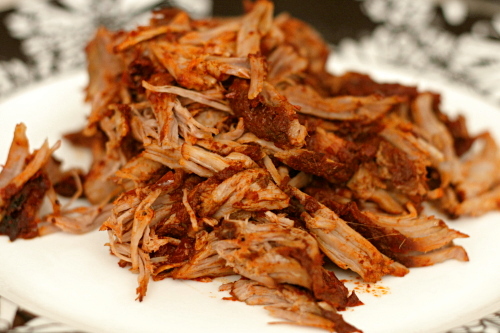
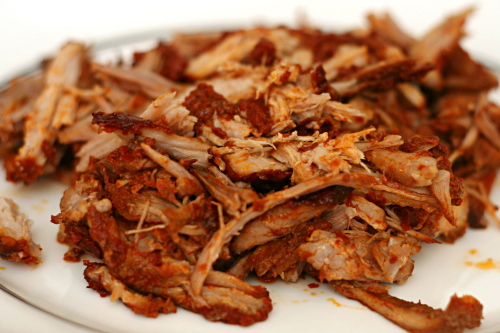
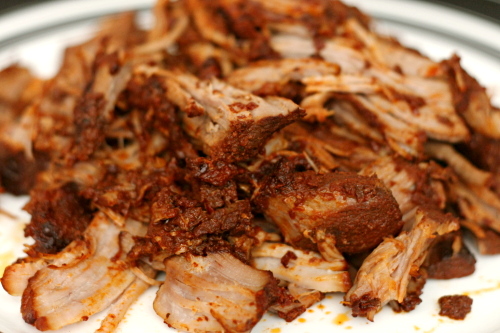






Hi Bridget! Thanks for the recipe. It looks tasty.
By the way, the right spelling is “carne adobada” (marinated meat).
(I’m a native Spanish speaker).
A lot of work goes into this but it looks well worth it. The pork looks fabulous.
Dominique – I’m not an expert in this, but a quick glance at wikipedia indicates that carne adovada is the New Mexican version of Mexico’s carne adobada.
Jason made carne adovada last weekend and forgot to marinate it. It’s tasty but has no heat at all. That could also have something to do with the homegrown chiles – it’s hard to judge how hot or mild they’ll end up.
I had never really heard of this dish, but OMGOSH I almost don’t care which one is better, as long as I get to have some. It looks sooooooo good!
this pig appeals to me on the most primitive level. i don’t know what it is about your preparation of it and lovely pictures, but i feel like ripping into it like a neanderthal. 🙂
Do you just serve it in a tortilla? It sounds like something my hubby would love, but I’m vegetarian. I’m thinking I could use seitan or tempeh with the marinade for a nice spicy taco filling.
This looks fabulous. I love food like this. Your post is really making me want to find the time to make it. I’ll probably make the spicy one because we love spicy Mexican food!
You’re posting recipes from July? Awesome. Now I don’t feel so bad. 😉
They all look amazing by the way!
I live outside of NM, and I’ve heard of Carne Adovada. I think I’ve eaten it, though. It looks like it’s worth the work! ¡Qué delicioso!
Hahaha – I made this. Today. (Jen’s recipe) Nearly swooned smelling it baking away.
I’m of Spanish descent and born in New Mexico and have cooked the traditional New Mexico dishes all my life. My grandmother used to have her own “horno” outside to make her bread, much like some of the Pueblos still have. These are outdoor ovens made of adobe. The Spaniards brought this concept with them when they migrated to The New World. The problem with too many recipes today is they’ve been changed from “old school” ways and spices have been added that have no business there. Why would anyone want to change the flavor of good New Mexico chile??? You can’t improve on perfection and that’s how we New Mexico cooks look at red and green chile. My family is a family of incredible New Mexico cooks and to see cumin and oregano in chile recipes is just wrong. Tasting these spices in this classic dish makes me gag……literally. They only belong in dishes like posole and menudo not in chile. My mother and grandmother would turn over in their collective graves if they tasted either in chile. The thing is, these spices change the entire flavor of chile which we consider a gift from the gods. Also, when making red chile, I toast the red chile pods for only about three minutes until I can smell it then remove it immediately from the oven. I can’t imagine toasting it for 10 minutes. Some people also strain the red chile to get rid of the unprocessed bits of chile. All that does is waste good chile. I simmer the toasted chile (after removing the stems, of course) on top of the stove for about 30-40 minutes (stirring on occasion), let it cool for a while then I put it in my Cuisinart for about 30 minutes so there are no visible bits of the chile. Add the garlic and some beef bullion cubes when you first put the chile in the food processor. You might want to give the Cuisinart or food processor a little rest at 20 minutes then do 15 or 20 more minutes. By the way, when buying the dried red chile, if it’s very, very dark red almost bordering on black, don’t buy it because it’s old chile. The finished product should be a bright beautiful red. Thin out with water but if you make a lot and if you want to freeze some, you might want to bag it then add water to thin it out when you’re ready to use it just to save space in the freezer. Hope these suggestions help.
Suzanne Castillo Devlin, you say you are spanish? I seriously dought that. I’ve been to Spain may times and their food is nothing close to Mexican or New Mexican food. Now your ancestors from the beginning may of originated from Spain like mine, who came from the Canarrie Islands to Nuevo Espana in 1500 (which is Mexico) (3 brothers from Lujan family). Our Fam tree goes back to 1500. Lujans. Now later in years (many years) any spaniard that was in Nuevo Espana was later called Mexico..from that point on everyone born were considered MEXICANS….dont forget the spanish married a lot of indians too. And New Mexcio was all part of what was MEXCIO…the spanish food went out several hundred years back. When was the last time you made Pallella? Or a real TORTILLA (which is a potatoe/egg omelete)? When was the last time you went out to a Spanish resturant or dance Flaminco?There is not much Spanish food served in the state of New Mexico and besides that whey does over 80% of our people here in NM say they are Spanish when in fact they are MEXICAN decent.. People really need to dig deep and study our history… just cuz our ancestors ions ago came from Spain does not make us Spanish…how often do you eat real spanish food? Or is it refried bean, flour/corn tortillas, chile (which is used very little in Spain)…Oh lots of hispanics in NM do not seafood yet a lot of SPANISH people thrive on seafood…
delicious!
as a native NM, i would suggest some sour cream and an over easy egg on top. also, i like a runny carne, kind of like a gravy, as the italians say with their marinara. the meat can get dry like a pot roast if youre not careful. combine with a corona or dos x or a margarita.
Papiuno: I just came across this after three years but if you read this, I’ll school you on New Mexico cooking and what I actually wrote about it and my roots to Spain.
Oh, so you seriously doubt I am of Spanish decent? Really? For the record, I traced my genealogy back to the Oñate expedition. And my roots to Spain are on both sides. Every person of Spanish decent didn’t inter-marry with the native peoples. although I can count a Greek and a Belgian in my family tree.
My family is full of these names: Sanchez, Vigil, Romero, Castillo, Saavedra, Chavez, Avila, Gabaldon, Gallegos, Pacheco and other names mostly found in the Land of Enchantment. I even have a Jojola in the family. All blue and green eyed like my mother and all her siblings. There are Spanish and Pueblo Indians named Jojola but the genesis or roots of that name are not clear.
I was merely attempting to distinguish the difference between New Mexico cooking (a mix of Spanish and Pueblo cooking) and Mexican cooking which are decidedly different. The Spaniards brought wheat, sheep, cattle, chickens and pigs to the New World and of course, the types of chile we enjoy today in New Mexico were native foods although other parts of the world also have grown different types of chilies.
It didn’t sit well that you essentially called me a liar. And I have been to Spain. In fact, I’m looking at a menu from Casa Botin right now. It’s the oldest continuously operating restaurant in the world according to Guinness book of world records. It’s located in Madrid and I’ve eaten there twice. It opened in 17 something.
I make my annual pilgrimage to Santa Fe every year and in fact, I leave for Santa Fe (via Albuquerque) this Thursday. Most of my family still lives there.
One of my first ancestors was in the New World was Hernan de Hinojos and he was the procurer for Juan de Onate’s expedition in 1598. Heard of Oñate???
Francisco de Salazar, another of my (of Spanish decent ancestors) was beheaded in the plaza in Santa Fe for complicity in the assassination of Governor Rosas in 1643. Look it up.
My family moved south from Santa Fe in around 1730 to the Sabinal area where they had their own little vineyard and made their own wine, something my grandparents had until my grandfather retired from the Santa Fe RR after 50 years.
Yes, Papiuno, I am of Spanish decent. In Spain, a tortillas is basically an omelet. I know the difference between Mexican and New Mexican cooking and I’d bet the house I could cook circles around you. And in New Mexico, the correct spelling is chile….. not chili, something that Tejanos eat.
I’ll add that anyone who adds cumin or oregano to “New Mexico” cooking should make their way back to Mexico where that is okay. Old school New Mexican cooks consider it a mortal sin punishable by death to add either of these to red chile. It totally alters the flavor of this food of the gods. Garlic and salt are the only thing it needs as far as adding a spice of sorts although I don’t know that garlic is considered an actual spice. Yes, add meat but that doesn’t change the taste of the chile like oregano or cumin do.
No wire hangers…… and not cumin or oregano to red chile.
I live in Seattle but born in Albuquerque and I think I was switched at birth… but I clearly remember my grandmother putting potatoes in with her chile pork when she cooked it? Anyone ever see or taste that?
I live in Oregon but was born in Belen, NM. Yes, I often put potatoes in my red chile (carne adovada) and always in my green chile stew. But…..I had never heard the word “adovada” until about 25 years ago and my family has been in New Mexico since 1598.